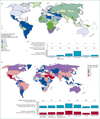Clinical management of concurrent diabetes and tuberculosis and the implications for patient services
- PMID: 25194887
- PMCID: PMC4852378
- DOI: 10.1016/S2213-8587(14)70110-X
Clinical management of concurrent diabetes and tuberculosis and the implications for patient services
Abstract
Diabetes triples the risk for active tuberculosis, thus the increasing burden of type 2 diabetes will help to sustain the present tuberculosis epidemic. Recommendations have been made for bidirectional screening, but evidence is scarce about the performance of specific tuberculosis tests in individuals with diabetes, specific diabetes tests in patients with tuberculosis, and screening and preventive therapy for latent tuberculosis infections in individuals with diabetes. Clinical management of patients with both diseases can be difficult. Tuberculosis patients with diabetes have a lower concentration of tuberculosis drugs and a higher risk of drug toxicity than tuberculosis patients without diabetes. Good glycaemic control, which reduces long-term diabetes complications and could also improve tuberculosis treatment outcomes, is hampered by chronic inflammation, drug-drug interactions, suboptimum adherence to drug treatments, and other factors. Besides drug treatments for tuberculosis and diabetes, other interventions, such as education, intensive monitoring, and lifestyle interventions, might be needed, especially for patients with newly diagnosed diabetes or those who need insulin. From a health systems point of view, delivery of optimum care and integration of services for tuberculosis and diabetes is a huge challenge in many countries. Experience from the combined tuberculosis and HIV/AIDS epidemic could serve as an example, but more studies are needed that include economic assessments of recommended screening and systems to manage concurrent tuberculosis and diabetes.
Copyright © 2014 Elsevier Ltd. All rights reserved.
Figures


References
-
- WHO. Global tuberculosis report 2013. Geneva: World Health Organization; 2013.
-
- Stevenson CR, Critchley JA, Forouhi NG, et al. Diabetes and the risk of tuberculosis: a neglected threat to public health? Chronic Illn. 2007;3:228–245. - PubMed
-
- Lönnroth K, Roglic G, Harries AD. Improving tuberculosis prevention and care through addressing the global diabetes epidemic: from evidence to policy and practice. Lancet Diabetes Endocrinol. 2014;2:730–739. - PubMed
Publication types
MeSH terms
Substances
Grants and funding
LinkOut - more resources
Full Text Sources
Other Literature Sources
Medical

